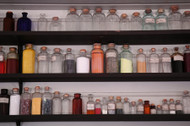Choosing the Right Leather Conditioner
Posted by Daniel Sutton on Apr 8th 2014
It's almost midnight. A hard day’s work has nestled you into the inviting cushion of your old wooden rocking chair, and the soft glow of your lamp is the only hindrance to your drifting eyelids. It is at this moment, at the vestibule between sight and slumber, that you espy your leather briefcase, mounted stoically upon the living room table. You take it in your hands, feeling its soft texture beneath your fingertips, and admire its rich color. How, you ask, could such perfection be made possible by mere mortal hands?
Currying makes it possible. At the beginning of the tanning process, leather is soaked in chemicals to prevent it from decomposing. The chemical bath causes the leather to become rigid and stiff, very unlike what you are touching right now. It is not until the currying process that your leather is restored to its supple nature. At this stage, the leather is soaked in natural fats and oils, allowing it dry softer and generally live a longer, happier life. But that's not the last conditioning the leather will ever need. Over time, leather loses those natural oils and slowly dries up. Periodically, these natural oils need to be replenished. Conditioning leather is a bit like conditioning your own skin. It increases the hide’s flexibility and fends off an epidemic of dryness and cracking.
The Options are Endless
So now that we've established conditioning stuff is generally a good idea, it's important to choose the right leather conditioner that's just right for the job. Is your head starting to spin at the sheer number of leather types you will be dealing with here? Yes? No? Well don’t worry. There are, in fact, a lot of different leather types – and they are not all created equal. First and foremost, know your leather! Don’t make the mistake of buying one conditioner and assuming it's the right leather conditioner for all your leather valuables. When you know the type of leather that you have, you can then judge the various conditioners to see which would be the best fit. Read about “How to Identify Types of Leather” here.
The Hard Decisions
When you are trying to determine the type of leather that you have, sometimes it is as simple as breaking it into categories, such as shoes, clothing or furniture. Chamberlain’s Furniture Treatment No. 5, for example, is formulated for most leather furniture, with the exception of some types of unfinished leather and suede. Read about unfinished leather in our blog "Leather Care for Finished and Unfinished Leather." Use Leather Care Liniment No. 1 to condition and rejuvenate your leather apparel and shoes . If you are using Leather Milk to condition dress shoes with a shiny finish, follow up with a good leather shoe polish to restore the shine. Note: Dress shoes will darken when a leather conditioner is applied. If you have exotic leather, such as ostrich or alligator, Chamberlains Leather Care Liniment No. 1 is also a great leather care option depending on the type of finish the leather has.
Even if you think you have found the perfect leather conditioner, make sure you test it in an area that can't be seen. There's nothing worse than giving your bag a nasty spot with the wrong leather conditioner. If you notice any discoloring or other negative, aesthetic effects, avoid using the product on that leather item.
Well, that's all folks. Conditioning leather is great, but make sure your leather conditioner is the right type. Leather is not uniform. So grab that briefcase and make it shine!
ContributorsStephanie Clarke
Chris Repp (www.leatherhelp.com)
Got more leather questions? Suggest a blog topic to us here!

